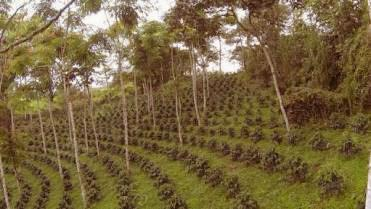
Taungya is
(a) A method of shifting cultivation
(b) Type of agroforestry practice
(c) Protection forestry
(d) Both (a) and (b)
Answer
579.6k+ views
Hint: It reduces the loss of fertility and helps make the land naturally fertile again by abandoning. This helps the soil to regain its natural nutrients.
Complete answer: Taungya is a method of shifting cultivation and agroforestry.
Cultivators are given the right to cultivate crops during the early stages of forest plantation establishment, in the taungya system. The cultivation of crops continues until the trees start shading the crops.
In shifting cultivation, an area is cleared and cultivated for a time until it loses its fertility. When the land becomes infertile for use, the farmer abandons it, shifts to a new plot for cultivation in the same process.
The land is left abandoned so that it could gain its natural fertility again. Some feel that this process harms the ecosystem and harms the economy while others take it as a method of conservation.
In agroforestry, the land is managed in a way that trees and shrubs are grown around crops.
Additional information:
1. The taungya system helps in growing a tree crop at a lesser cost and also increases food production.
2. Food crops may be damaged during tree-harvesting. Trees that together form a part of agroforestry systems may be the hosts of insects and birds that can damage crops.
3. Protection forestry is the forest that prevents the impact of a natural hazard, over the people and their assets living in the mountainous areas
So the correct answer is ‘Taungya is a method of shifting cultivation and also a type of agroforestry practice’

Notes:
1. American economic geographer J. Russell Smith in his book Tree Crops: A Permanent Agriculture (1929) outlined agroforestry. He believed that tree-based agriculture was better than permanent agriculture.
2. Protection forestry protects against rockfall, avalanche, erosion, landslide, debris flow, or flooding.
Complete answer: Taungya is a method of shifting cultivation and agroforestry.
Cultivators are given the right to cultivate crops during the early stages of forest plantation establishment, in the taungya system. The cultivation of crops continues until the trees start shading the crops.
In shifting cultivation, an area is cleared and cultivated for a time until it loses its fertility. When the land becomes infertile for use, the farmer abandons it, shifts to a new plot for cultivation in the same process.
The land is left abandoned so that it could gain its natural fertility again. Some feel that this process harms the ecosystem and harms the economy while others take it as a method of conservation.
In agroforestry, the land is managed in a way that trees and shrubs are grown around crops.
Additional information:
1. The taungya system helps in growing a tree crop at a lesser cost and also increases food production.
2. Food crops may be damaged during tree-harvesting. Trees that together form a part of agroforestry systems may be the hosts of insects and birds that can damage crops.
3. Protection forestry is the forest that prevents the impact of a natural hazard, over the people and their assets living in the mountainous areas
So the correct answer is ‘Taungya is a method of shifting cultivation and also a type of agroforestry practice’

Notes:
1. American economic geographer J. Russell Smith in his book Tree Crops: A Permanent Agriculture (1929) outlined agroforestry. He believed that tree-based agriculture was better than permanent agriculture.
2. Protection forestry protects against rockfall, avalanche, erosion, landslide, debris flow, or flooding.
Recently Updated Pages
Master Class 12 Business Studies: Engaging Questions & Answers for Success

Master Class 12 Economics: Engaging Questions & Answers for Success

Master Class 12 English: Engaging Questions & Answers for Success

Master Class 12 Maths: Engaging Questions & Answers for Success

Master Class 12 Social Science: Engaging Questions & Answers for Success

Master Class 12 Chemistry: Engaging Questions & Answers for Success

Trending doubts
Who was the first woman to receive Bharat Ratna?

Write a letter to the principal requesting him to grant class 10 english CBSE

Why is there a time difference of about 5 hours between class 10 social science CBSE

What is the median of the first 10 natural numbers class 10 maths CBSE

The Equation xxx + 2 is Satisfied when x is Equal to Class 10 Maths

Discuss the main reasons for poverty in India




